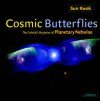![Cosmic Butterflies Cosmic Butterflies]()
Click to have a closer look
About this book
Contents
Biography
Related titles
About this book
At the end of a star's life, it wraps itself in a cocoon by spilling out gas and dust. Sometime later, a butterfly-like nebula emerges from the cocoon and develops into a planetary nebula. They are among the most beautiful of the celestial objects imaged by the Hubble Space Telescope. Their structures, like bubbles floating in the void, are complemented by a kaleidoscope of colour emitted by glowing gases. Delicate, lacelike, streamers of gas add to their complexity. The production of a planetary nebula by a star is a milestone in the life of a star, an event that foretells the doom of the star when its central energy source runs out. In this book, Sun Kwok tells the story of the discovery process of the creation of planetary nebulae and of the future of the Sun. Full colour illustrations are included throughout the book.
Contents
1. Planetary nebulae - the last hurrah in the life of a star; 2. The shapes and colors of planetary nebulae; 3. How do planetary nebulae shine?; 4. The young and old; 5. Where do planetary nebulae come from and what will they become?; 6. The end of lives of stars: white dwarfs, neutron stars, or black holes?; 7. What is the source of power; 8. Star dust; 9. Gone with the wind; 10. Not with a bang but a whimper; 11. A morphological menagerie; 12. Butterflies in the sky; 13. The missing link; 14. Stellar metamorphosis; 15. Unsolved mysteries; 16. How many are there?; 17. Measuring the size and mass of the universe with planetary nebulae; 18. Old stars as molecular factories; 19. Do we owe our lives to planetary nebulae; 20. Glossary; 21. Some commonly observed planetary nebulae; 22. Further readings; 23. Notes on images.
Customer Reviews
Biography
Dr. Sun Kwok, professor of astronomy and Canada Council Killam Fellow, is a leading world expert in planetary nebulae. He serves as the chairman of the Planetary Nebulae Working Group of the International Astronomical Union, and is the co-chair of the 2001 IAU symposium on planetary nebulae in Canberra, Australia.
Out of Print
By: Sun Kwok
190 pages, 3 line diagrams, 24 half-tones, 117 colour plates
'In this book, Sun Kwok tells the story of the discovery process of the creation of planetary nebulae and of the future of the Sun.' Europe & Astronomy 'Despite the more than one hundred beautiful Hubble Space Telescope (HST images, this is not just another 'pretty' coffee-table book ! a good but brief discussion of the images, their acquisition with the HST and subsequent processing, rounds off this fine work ! the visual appeal of this book is enormous.' Auke Slotegraaf, MNASSA '! the highlight of this superbly produced volume is the collection of nearly 100 beautiful images of planetary nebulae - few of which were previously available.' Don Pollacco, The Observatory '! this is an excellent book. I thoroughly recommend it to anyone with an interest in one of the most fascinating classes of object in the night sky. If you want to know how the Sun will evolve in a few billion years time, this is the book to read.' Stewart Moore, The Webb Society Deep Sky Observer



































